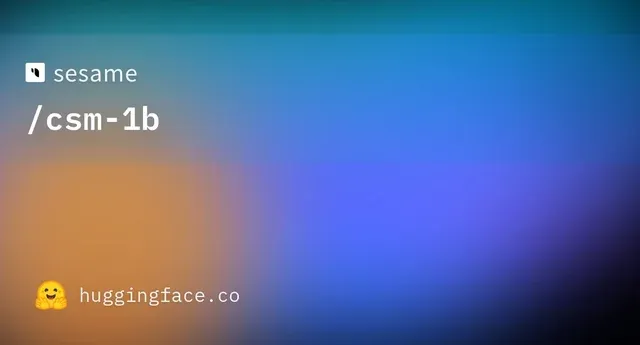
Text-to-speech (TTS) technology has long been a staple of virtual assistants, accessibility tools, and interactive systems. But the latest player on the scene, Sesame CSM-1B, isn’t just turning text into robotic-sounding speech—it’s aiming to elevate speech synthesis into the realm of natural, context-aware conversations. Built atop the Llama transformer architecture and infused with novel audio codec tech, CSM-1B blends text and audio inputs into expressive, human-like speech outputs. Let’s unpack what makes it a breath of fresh air in the speech AI space.
Unlike your garden-variety TTS engines that mechanically read out standalone text snippets, Sesame CSM-1B is designed to converse. It’s a Conversational Speech Model (likely the origin of the “CSM” in its name), capable of maintaining context across dialogue turns. This means it doesn’t just parrot words—it adjusts tone, pitch, and expressiveness depending on the emotional and conversational cues it picks up. The result? Speech that sounds more natural and less like a talking toaster.
What’s particularly clever is how Sesame CSM-1B handles inputs: it processes both text and audio simultaneously through its transformer-based multimodal architecture. This dual-input processing enables the model to capture nuances from a user’s voice or prior utterances and blend them with the textual content to produce a coherent, contextually relevant vocal output. This is a step beyond traditional pipelines where speech synthesis is a one-way text-to-audio street.
A standout feature under the hood is the integration of Kyutai’s Mimi audio codec technology, which compresses speech data down to a mere 1.1 kbps without sacrificing quality. Instead of generating raw waveforms—a computationally heavy operation—CSM-1B produces Residual Vector Quantization (RVQ) audio codes that a vocoder or similar synthesizer transforms into the final waveform. This approach ensures the speech remains rich and natural while keeping resource demands manageable, allowing the model to run across a variety of hardware setups, from beefy GPUs to more modest CPUs.
At around 1 billion parameters, Sesame CSM-1B is compact compared to gargantuan LLMs, striking a balance between performance and accessibility. This means developers and researchers can experiment with it without needing supercomputer-sized infrastructure.
The open-source community has already begun harnessing CSM-1B’s capabilities. For instance, the voice cloning toolkit by Isaiah Bjork enables users to create personalized voice models from just a few minutes of audio. Although it’s not the holy grail of voice cloning—results are decent but not flawless—the toolkit offers both local GPU and cloud (Modal) execution options, making it flexible for hobbyists and pros alike. For those running into tensor dimension errors or memory woes, tweaking sequence lengths and sample durations is part of the game.
Beyond cloning, a curated collection of applications (awesome-csm-1b) showcases how the model can power everything from audiobook narration and personal voice diaries to emotion-driven speech synthesis and multilingual accent generation. These projects leverage modern Python stacks—FastAPI for backend APIs and Streamlit for user interfaces—making deployment and experimentation straightforward.
While established TTS services like ElevenLabs have set high bars for voice quality and expressiveness, Sesame CSM-1B distinguishes itself by emphasizing conversational context and multimodal input fusion. It doesn’t generate text; instead, it pairs perfectly with LLMs that handle language generation, focusing its firepower on producing speech that sounds right in context. This modular design suggests a future where AI agents can chat with us more naturally, switching tones, emotions, and voices on the fly.
In 2025, as AI agents ramp up in sophistication, models like Sesame CSM-1B could be the engine behind more engaging virtual assistants, interactive storytelling, and customer support bots that don’t just talk but listen and respond with nuance.
If you’re curious to try it yourself, the model and code are publicly accessible (with a Hugging Face account and token), and the growing ecosystem promises plenty of room for experimentation. Whether your goal is to build a chatbot with a personality or bring your audiobook projects to life with expressive narration, Sesame CSM-1B offers a compelling, open-source alternative in the evolving landscape of speech AI.
